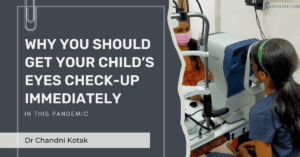Imagine a world without colors, shapes, or the joy of reading a beloved storybook. Our vision is a precious gift, especially for children, who rely on it to explore and learn about the world around them. As parents and caregivers, it is our responsibility to ensure that their eyes are healthy and their vision is optimized from an early age. In this blog, we will shed light on the importance of early eye care for children, delve into common pediatric eye conditions such as amblyopia (lazy eye) and strabismus (crossed eyes), and explore the remarkable advancements in diagnostic techniques and treatment options available today.
Did you know that your child’s vision plays a crucial role in their overall development and academic success? By understanding the significance of early eye care and being aware of common pediatric eye conditions, we can take proactive steps to protect our children’s vision and help them thrive.
The Importance of Early Eye Care:
Many eye conditions in children can go unnoticed without regular eye examinations. Early detection is key to successful treatment and preventing long-term visual impairment. The American Academy of Ophthalmology recommends that children undergo their first comprehensive eye examination between the ages of 6 and 12 months, followed by regular check-ups at specific intervals throughout their childhood.
Common Pediatric Eye Conditions:
1. Amblyopia (Lazy Eye):
Amblyopia is a condition in which one eye develops better vision than the other. It can occur due to a variety of factors, such as crossed eyes, unequal refractive errors (prescription differences), or a significant difference in visual input between the two eyes. If left untreated, amblyopia can lead to permanent vision loss in the weaker eye. Early detection and intervention, usually through patching or blurring the stronger eye, can help restore proper vision.
2. Strabismus (Crossed Eyes):
Strabismus refers to the misalignment of the eyes, causing one or both eyes to turn inward, outward, upward, or downward. This condition affects the coordination of eye movements and can result in double vision or poor depth perception. Treatment options for strabismus include eyeglasses, eye exercises, and in some cases, surgery to realign the eyes.
Modern Diagnostic Techniques:
Advancements in technology have revolutionized the field of pediatric eye care, making diagnosis more accurate and efficient than ever before. Here are some modern diagnostic techniques used in assessing children’s eye health:
1. Retinoscopy: This non-invasive technique helps determine a child’s refractive error by shining a light into their eyes and observing the reflection. It allows ophthalmologists to measure the eye’s focusing ability, guiding the prescription for corrective lenses if needed.
2. Pediatric Vision Screening: Various screening tools, such as photo screening devices and visual acuity tests, have been developed to detect potential vision problems in young children who may not be able to communicate their visual difficulties effectively.
Components of a Pediatric Eye Exam
As a concerned parent, you may find yourself wondering what to expect during your child’s eye exam. Rest assured, a comprehensive pediatric eye examination involves several important tests that provide valuable insights into your child’s visual health and development. Let’s explore some of the common and informative tests typically conducted during a pediatric eye exam:
Visual Acuity Test: The visual acuity test serves as a fundamental assessment of your child’s visual sharpness. It involves the utilization of a projected eye chart to measure distance visual acuity, as well as a handheld acuity chart to evaluate near vision at a standardized reading distance. By accurately measuring visual acuity, the ophthalmologist can gauge the clarity of your child’s vision.
Cover Test: The cover test is a straightforward examination technique that allows the pediatric ophthalmologist to assess how well your child’s eyes function together. During this test, your child will be asked to focus on a small object placed across the room, while the ophthalmologist alternately covers each eye. The test is then repeated with a nearby object at a shorter distance. By observing how the uncovered eye moves to fixate on the target, the ophthalmologist can detect conditions such as strabismus (misalignment of the eyes) or subtle binocular vision problems that could lead to eye strain or amblyopia, commonly known as “lazy eye.”
Amblyopia, often manifested in childhood, can vary in causes and risk factors for each child. Signs of amblyopia may include squinting, shutting one eye, head tilting, or difficulties in perceiving depth. Early diagnosis and treatment before the age of seven offer the best opportunity for complete resolution. That’s why it is crucial to have your child undergo vision tests before they enter school-age, ensuring any issues are addressed promptly.
Eye Movement Test: The evaluation of eye movements, known as Ocular Motility Testing, assesses the ability of your child’s eyes to follow a moving object smoothly and accurately shift focus between two separate objects. Problems with eye movements can lead to blurred vision, eye strain, headaches, and related complications. To examine smooth eye movements, the pediatric ophthalmologist will ask your child to hold their head steady while tracking the slow movement of a handheld light or another object solely with their eyes. Additionally, your child may be requested to shift their gaze back and forth between two targets positioned at varying distances, allowing the ophthalmologist to evaluate rapid eye movements.
By conducting these tests and utilizing their expertise, pediatric ophthalmologists can obtain a comprehensive understanding of your child’s visual health, identify any potential concerns, and develop appropriate treatment plans if necessary.
Treatment Options:
1. Glasses: Prescription eyeglasses are a common and effective solution for correcting refractive errors, such as nearsightedness, farsightedness, and astigmatism. Modern eyeglasses are available in various styles and designs to suit children’s preferences and needs.
2. Vision Therapy: Vision therapy comprises a series of specialized exercises and activities aimed at improving visual skills, such as eye tracking, focusing, and depth perception. It is often used as a non-surgical approach to treat conditions like amblyopia and strabismus.
3. Surgical Interventions: In cases where nonsurgical methods are insufficient, surgical options may be considered to correct misalignment of the eyes or address certain eye conditions. Ophthalmologists with expertise in pediatric ophthalmology can provide guidance on the suitability of surgical interventions.
Conclusion:
Your child’s vision is priceless, and investing in their eye care from an early age is essential. By understanding the significance of regular eye examinations, recognizing common pediatric eye conditions like amblyopia and strabismus, and staying informed about the advancements in diagnostic techniques and treatment options, we can help protect our children’s vision and set them on a path towards a bright and successful future. Remember, early intervention is the key to optimizing their visual development and ensuring a lifetime of clear and healthy vision.
Sources:
– American Academy of Ophthalmology (www.aao.org)
– Mayo Clinic (www.mayoclinic.org)
– All About Vision (www.allaboutvision.com)
– National Eye Institute (www.nei.nih.gov)





